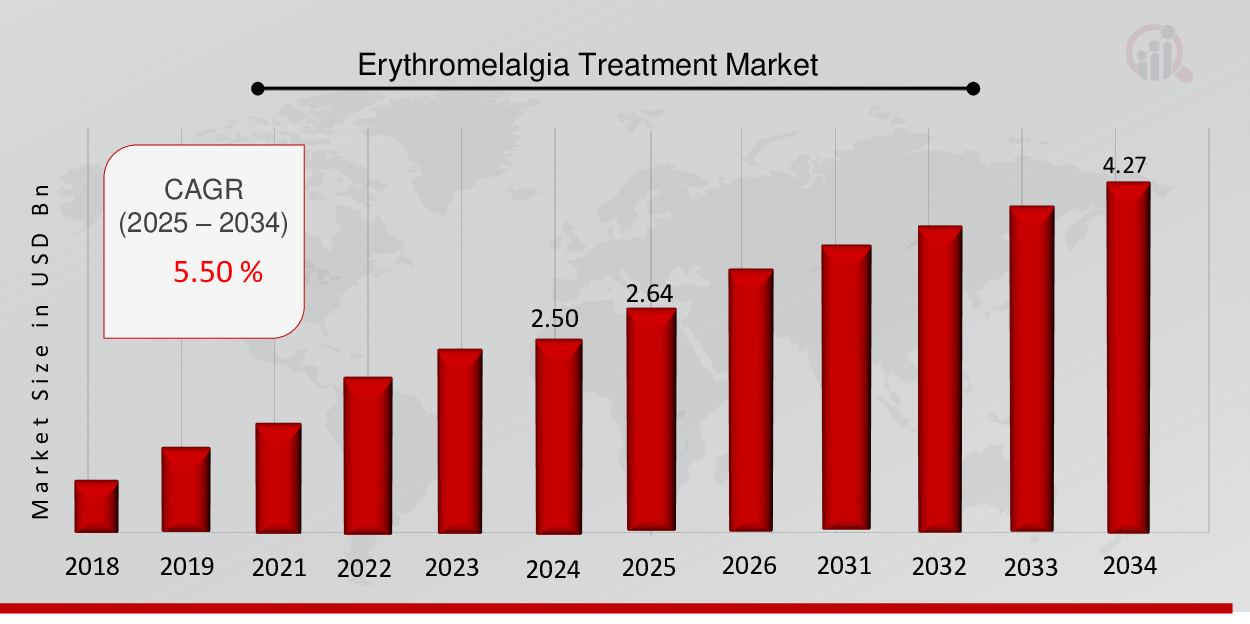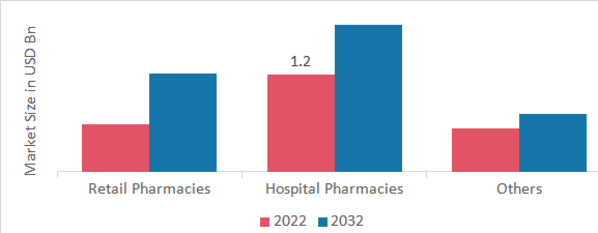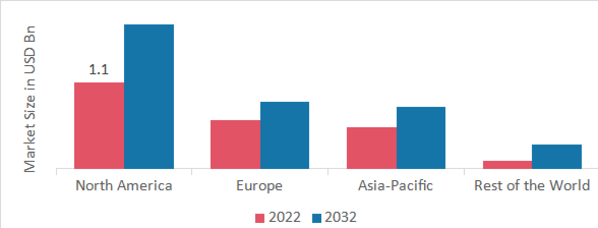Erythromelalgia treatment Market Overview
As per MRFR analysis, the Erythromelalgia Treatment Market Size was estimated at 2.5 (USD Billion) in 2024. The Erythromelalgia Treatment Market Industry is expected to grow from 2.64 (USD Billion) in 2025 to 4.27 (USD Billion) till 2034, at a CAGR (growth rate) is expected to be around 5.50% during the forecast period (2025 - 2034). Increase in the number of patients with erythromelalgia, strong product pipeline, high demand for disease-specific novel, unmet medical need, growing investment in orphan drug development, rise of precision medicine, advances in drug discovery technologies, growing healthcare expenditure, are the key market drivers enhancing the market growth.

Source: Secondary Research, Primary Research, MRFR Database and Analyst Review
Erythromelalgia treatment Market Trends
Growing investment in orphan drug development is driving the market growth
The pharmaceutical business has been greatly impacted by the increasing investment in orphan drug development, which has resulted in a fundamental change in drug research and development strategy. Orphan drugs are pharmaceuticals created to treat rare disorders, which frequently only impact a small percentage of people. These illnesses, which are also referred to as orphan diseases or rare diseases together, present particular difficulties because they have small patient populations and ineffective medical interventions. The focus on orphan drug development has increased as a result of a number of factors that interact favorably for both patients and pharmaceutical businesses.
Many regulatory bodies, including the European Medicines Agency (EMA) and the U.S. Food and Drug Administration (FDA), have created specific approval processes for orphan drugs. These paths frequently feature accelerated review procedures, decreased costs, and prolonged periods of market exclusivity. Such incentives help patients get access to life-saving treatments more quickly while also encouraging pharmaceutical corporations to invest in the development of orphan drugs.
The economic climate has changed in favor of the creation of orphan drugs. Even while individual patient groups with uncommon diseases may be small, the overall impact is significant. Around 400 million people are thought to be affected by uncommon diseases globally, which emphasizes the need of focusing on this group of people. The development of precision medicine and improvements in genetic research have made it possible to pinpoint precise molecular targets for a variety of uncommon disorders. The likelihood for successful outcomes is increased by this individualized approach to therapy development, which also helps to fuel the rising interest in the research and development of orphan drugs.
Pharmaceutical firms are becoming more and more aware of the strategic benefits of funding orphan medications. Despite being small, the orphan drug market has a number of benefits that business participants find appealing. First, the limited patient populations may result in less rivalry, increasing the chance of market exclusivity and steady revenue streams. Furthermore, because there are few alternatives and a desperate need for effective therapies, orphan medications frequently carry a premium price. Even with lower sales quantities, this can produce a fair return on investment.
In the environment of orphan drug development, collaboration has become a key tactic. Partnerships among pharmaceutical corporations, academic institutions, patient advocacy organizations, and governing authorities are increasingly common. Through these partnerships, medication development is accelerated, trial designs are optimized, and challenging regulatory procedures are navigated. Stakeholders can overcome obstacles that might be insurmountable when handled separately by combining their resources and expertise. Thus, driving the Erythromelalgia treatment market revenue.
Erythromelalgia treatment Market Segment Insights
Erythromelalgia Treatment Type Insights
The Erythromelalgia treatment Market segmentation, based on type, includes Primary Erythromelalgia, Secondary Erythromelalgia. The primary erythromelalgia segment dominated the market in 2022. The ailment erythromelalgia is difficult to manage, and there is no known cure as of yet. There is a sizable unmet medical need because of our incomplete understanding of its underlying mechanisms and the dearth of focused treatments. To find effective treatments and raise the quality of life for those who are affected, research and development efforts are motivated by this need.
Erythromelalgia Treatment Insights
The Erythromelalgia treatment Market segmentation, based on Treatment, includes Medication, Surgery. The medication segment dominated the market in 2022. This is due to the fact that there are currently no FDA-approved surgical treatments for erythromelalgia. The available medications are often effective in managing the symptoms of the disease, and therefore, the medication segment is larger.
Erythromelalgia Treatment Drugs Insights
The Erythromelalgia treatment Market segmentation, based on Drugs, includes Lidocaine, Capsaicin, Diclofenac, Brimonidine, Misoprostol and Others. The diclofenac drug dominated the market in 2022. The formulations of diclofenac include oral pills, capsules, topical gels, creams, and patches. This adaptability gives medical personnel the tools they need to customize care to each patient's requirements and preferences, improving adherence and satisfaction.
Erythromelalgia Treatment Route of Administration Insights
The Erythromelalgia treatment Market segmentation, based on Route of Administration, includes Oral, Topical. The oral segment dominated the market in 2022. The strong patient acceptance and compliance rates of the oral route are one of the main factors contributing to its popularity. Patients are more likely to follow their recommended treatment plans when taking medication orally since it is comfortable, convenient, and non-invasive. This is especially important for managing chronic illnesses, which require long-term adherence.
Erythromelalgia Treatment End- Users Insights
The Erythromelalgia treatment Market segmentation, based on End- Users, includes Hospitals, Homecare, Specialty Clinics, Others. The hospitals segment dominated the market in 2022. Hospitals have the necessary infrastructure and expertise to provide comprehensive care for patients with erythromelalgia. This includes diagnostic testing, treatment, and follow-up care.
Erythromelalgia Treatment Distribution Channel Insights
The Erythromelalgia treatment Market segmentation, based on distribution channel, includes Hospital Pharmacies, Retail Pharmacies and Others. The hospital pharmacies category generated the most income in 2022. Hospital pharmacies are the primary source of erythromelalgia treatment medications. They have a wide range of medications available, and they can provide specialized expertise and advice on the use of these medications.
Figure 1: Erythromelalgia treatment Market, by Distribution channel, 2022 & 2032 (USD Billion)

Source: Secondary Research, Primary Research, MRFR Database and Analyst Review
Erythromelalgia Treatment Regional Insights
By region, the study provides the market insights into North America, Europe, Asia-Pacific and Rest of the World. The North America Erythromelalgia treatment Market dominated this market in 2022 (45.80%). Numerous prestigious research universities, medical schools, and pharmaceutical firms are located in North American nations. The existence of these institutions encourages considerable study into uncommon diseases, drawing leading scientists and medical professionals to concentrate on unraveling the underlying mechanisms of erythromelalgia and creating effective treatments. Further, the U.S. Erythromelalgia treatment market held the largest market share, and the Canada Erythromelalgia treatment market was the fastest growing market in the North America region.
Further, the major countries studied in the market report are The U.S., Canada, German, France, the UK, Italy, Spain, China, Japan, India, Australia, South Korea, and Brazil.
Figure 2: Erythromelalgia treatment Market SHARE BY REGION 2022 (USD Billion)

Source: Secondary Research, Primary Research, MRFR Database and Analyst Review
Europe Erythromelalgia treatment market accounts for the second-largest market share. Patient advocacy groups and organizations for rare diseases actively try to increase public awareness of diseases like erythromelalgia. These organizations work together with researchers, healthcare providers, and legislators to increase awareness, support, and funding for the development of cures and the enhancement of patient outcomes. Further, the German Erythromelalgia treatment market held the largest market share, and the UK Erythromelalgia treatment market was the fastest growing market in the European region.
The Asia-Pacific Erythromelalgia treatment Market is expected to grow at the fastest CAGR from 2023 to 2032. Due to variances in healthcare infrastructure, economic growth, and geographic variables, access to healthcare can vary greatly within the Asia Pacific area. In order to address erythromelalgia in underserved areas, it is essential to guarantee equal access to diagnostic and therapeutic options. Moreover, China’s Erythromelalgia treatment market held the largest market share, and the Indian Erythromelalgia treatment market was the fastest growing market in the Asia-Pacific region.
Erythromelalgia Treatment Key Market Players & Competitive Insights
Leading market players are investing heavily in research and development in order to expand their product lines, which will help the Erythromelalgia treatment market, grow even more. Market participants are also undertaking a variety of strategic activities to expand their global footprint, with important market developments including new product launches, contractual agreements, mergers and acquisitions, higher investments, and collaboration with other organizations. To expand and survive in a more competitive and rising market climate, Erythromelalgia treatment industry must offer cost-effective items.
Manufacturing locally to minimize operational costs is one of the key business tactics used by manufacturers in the global Erythromelalgia treatment industry to benefit clients and increase the market sector. In recent years, the Erythromelalgia treatment industry has offered some of the most significant advantages to medicine. Major players in the Erythromelalgia treatment market, including Teva Pharmaceutical Industries Ltd, Xenon, Biogen, ICAGEN, INC, Pfizer Inc, Zydus Cadila, ANI Pharmaceuticals, Inc, Novel Laboratories Inc, Norvartis AG, Amneal Pharmaceuticals LLC, ALLERGAN, Bausch Health, Akorn, Incorporated, INDOCO REMEDIES LTD, Somerset Therapeutics, LLC, Galderma Laboratories, L.P., and Acorda Therapeutics, Inc, among other, are attempting to increase market demand by investing in research and development operations.
The creation, manufacture, and marketing of prescription and over-the-counter medications, as well as items for eye care, are the areas of expertise of a healthcare company by the name of Novartis AG (Novartis). It provides medications for treating solid tumors, immune system problems, infections, cardiovascular disease, dermatological problems, neurological problems, ophthalmic and respiratory illnesses, cancer, and neurological abnormalities, among other conditions. The company sells biosimilars and generic drugs through Sandoz. Novartis conducts research in several disease-related sectors through the Novartis Institutes for BioMedical Research (NIBR). The company operates a network of companies and offices in the Americas, Europe, the Middle East, Africa, and Asia-Pacific. The Novartis corporate headquarters are located in Basel, Switzerland.
Amneal Pharmaceuticals Inc. (Amneal) is a pharmaceutical firm that develops, manufactures, and sells medicines. Pharmaceuticals, both generic and specialty, are sold by the company. It also makes Activella, Albenza, Dexedrine, Nizatidine Oral Solution, Pyridiu, and medications for oncology, inflammation and pain, disorders of the central nervous system, endocrinology, and parasitic infections. Amneal sells products in a variety of dosage forms, such as oral solids and liquids, injectables, topicals, creams and ointments, transdermals, inhalation, ophthalmic and otic liquids, and other device-driven products. Hospitals, chain pharmacies, individual pharmacies, wholesalers, and distributors are among the clients it serves. The company has operations in India, the UK, Ireland, and Switzerland. Amneal's headquarters are in Bridgewater, New Jersey, in the US.
Key Companies in the Erythromelalgia Treatment Market Include
- Teva Pharmaceutical Industries Ltd
- Xenon
- Biogen
- ICAGEN, INC
- Pfizer Inc
- Zydus Cadila
- ANI Pharmaceuticals, Inc
- Novel Laboratories Inc
- Norvartis AG
- Amneal Pharmaceuticals LLC
- ALLERGAN
- Bausch Health
- Akorn, Incorporated
- INDOCO REMEDIES LTD
- Somerset Therapeutics, LLC
- Galderma Laboratories
- L.P.
- Acorda Therapeutics, Inc
Erythromelalgia treatment Industry Developments
July 2023:Amneal Pharmaceuticals LLC announced the launch of its authorized generic for Xyrem1 (Sodium Oxybate) oral solution CIII in the US.
May 2023:Amneal Pharmaceuticals LLC announced the commercial launch of FYLNETRA (pegfilgrastim-pbbk), a biosimilar referencing Neulasta in a pre-filled single-dose syringe.
Erythromelalgia treatment Market Segmentation
Erythromelalgia treatment Type Outlook
- Primary Erythromelalgia
- Secondary Erythromelalgia
Erythromelalgia treatment Treatment Outlook
Erythromelalgia treatment Drugs Outlook
- Lidocaine
- Capsaicin
- Diclofenac
- Brimonidine
- Misoprostol
- Others
Erythromelalgia treatment Route of Administration Outlook
Erythromelalgia treatment End- Users Outlook
- Hospitals
- Homecare
- Specialty Clinics
- Others
Erythromelalgia treatment Distribution Channel Outlook
- Hospital Pharmacies
- Retail Pharmacies
- Others
Erythromelalgia Treatment Regional Outlook
| Report Attribute/Metric |
Details |
|
Market Size 2024
|
2.50 (USD Billion)
|
|
Market Size 2025
|
2.64 (USD Billion)
|
|
Market Size 2034
|
4.27 (USD Billion)
|
|
Compound Annual Growth Rate (CAGR)
|
5.50 % (2025 - 2034)
|
|
Report Coverage
|
Revenue Forecast, Competitive Landscape, Growth Factors, and Trends
|
|
Base Year
|
2024
|
|
Market Forecast Period
|
2025 - 2034
|
|
Historical Data
|
2020 - 2024
|
| Report Coverage |
Revenue Forecast, Market Competitive Landscape, Growth Factors, and Trends |
| Segments Covered |
Type, Treatment, Drugs, Route of Administration, End- Users, Distribution Channel, and Region |
| Geographies Covered |
North America, Europe, Asia Pacific, and the Rest of the World |
| Countries Covered |
The U.S., Canada, German, France, UK, Italy, Spain, China, Japan, India, Australia, South Korea, and Brazil |
| Key Companies Profiled |
Teva Pharmaceutical Industries Ltd, Xenon, Biogen, ICAGEN, INC, Pfizer Inc, Zydus Cadila, ANI Pharmaceuticals, Inc, Novel Laboratories Inc, Norvartis AG, Amneal Pharmaceuticals LLC, ALLERGAN, Bausch Health, Akorn, Incorporated, INDOCO REMEDIES LTD, Somerset Therapeutics, LLC, Galderma Laboratories, L.P., and Acorda Therapeutics, Inc, among other domestic and global players. |
| Key Market Opportunities |
Rising prevalence of erythromelalgia |
| Key Market Dynamics |
R and D |
Erythromelalgia Treatment Market Highlights:
Frequently Asked Questions (FAQ) :
The Erythromelalgia treatment Market size was valued at USD 2.25 Billion in 2022.
The global market is projected to grow at a CAGR of 5.50% during the forecast period, 2023-2032.
North America had the largest share in the global market
The key players in the market are Teva Pharmaceutical Industries Ltd, Xenon, Biogen, ICAGEN, INC, Pfizer Inc, Zydus Cadila, ANI Pharmaceuticals, Inc, Novel Laboratories Inc, Norvartis AG, Amneal Pharmaceuticals LLC, ALLERGAN, Bausch Health, Akorn, Incorporated, INDOCO REMEDIES LTD, Somerset Therapeutics, LLC, Galderma Laboratories, L.P., and Acorda Therapeutics, Inc, among other domestic and global players.
The Primary Erythromelalgia category dominated the market in 2022.
The Hospital Pharmacies had the largest share in the global market.

















